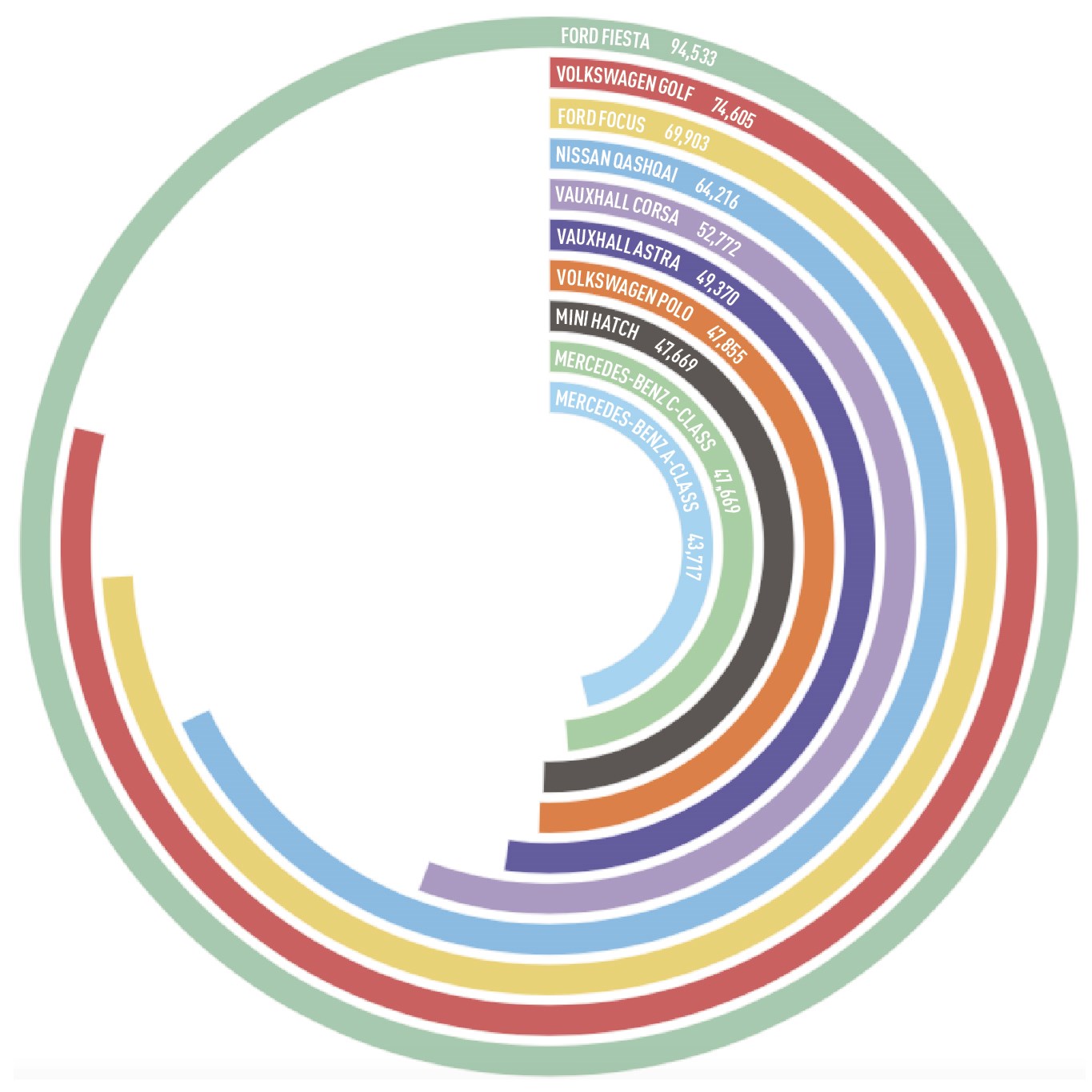 The 5.7% year-on-year decline in the 2017 new car market was not a surprise to dealers, but while many manufacturers saw double-digit falls in registrations, the market was still at the third-highest level in a decade, at 2.54 million units.
The 5.7% year-on-year decline in the 2017 new car market was not a surprise to dealers, but while many manufacturers saw double-digit falls in registrations, the market was still at the third-highest level in a decade, at 2.54 million units.
A record 2016 has resulted in some negative drops for year-on-year comparisons.
Private, fleet and business registrations were all down in 2017, with demand from private motorists declining -6.8%, while fleets saw a fall of -4.5%. The biggest percentage losses were seen in business registrations, with the sector ending the year down -7.8%.
Demand for petrol cars increased by 2.7%. However, this was not enough to offset a -17.1% decline in diesel registrations – with negative headlines about diesel and the potential for tax increases causing buyers to hesitate. The SMMT’s current forecast is predicting a 5.4% drop in new car registrations in 2018 to a market of 2.426 million units (See our news insight on page 6). Diesel’s share of the market is expected to continue to fall, to 40.7% of the total car market.
The winners
The stand-out performer for 2017 was Seat, with an increase in registrations of 18.28%, to 56,130.
This impressive increase was largely due to huge gains in the fleet market, up 33.7% to 31,951 units, making it the second-best performance in fleet growth last year after Suzuki.
New model launches can always help to lift a manufacturer’s fortunes and Seat has seen strong demand from its Ateca SUV, launching the brand into a new segment.
The Ateca has helped Seat grow in the fleet market as it was previously reliant on the Leon. Order books also opened for its new Arona small SUV in October last year and the brand also launched a revised Leon and new Ibiza within the space of 12 months.
Fleet initiatives included four-day test drives to convince user-choosers and fleet managers and a £12,000 annual incentive for dealers that met a new set of fleet sales standards. Part of this additional incentive included hitting 100 fleet deals a year.
In terms of sheer volume, Mercedes-Benz stands out for growth of 6.56%, or 11,142 units, to a total of 180,970 last year. This makes Mercedes the biggest premium brand in the UK and puts it almost 6,000 units clear of rivals BMW and Audi, which both had a flat 2017.
Mercedes grew its fleet volumes by 13.94% in 2017, to 93,128 units. This compares with a 2.4% drop in retail volumes, down to 74,859 units.
The A-Class was Mercedes’ most successful fleet model last year, up 20.32% to 29,114 units. This helped to offset the 6.15% drop in fleet sales of the C-Class, which still represented the second-biggest chunk of Mercedes’ fleet registrations at 25,563 units.
The biggest growth segment for Mercedes was its G/GLE/GLC Class products, up 45.3% in the fleet market to 10,136 units.
Suzuki also had a strong 2017, with total registrations up by 40,343 units, bolstered by gains in the fleet market of 52.96%, to 14,426 units. This was helped by the strong growth from Vitara with fleets, up 79.38% to 5,733 units.
Suzuki actually recorded gains in the fleet market across its entire model range, with the new Swift and SX4 S-Cross turning in particularly strong performances, up 29.09% and 28.54% respectively.
The losers
While Jeep, DS and Fiat had a torrid 2017 with big losses, it was Vauxhall that had a devastating total fall in volumes of 22.24%, or 55,818 units. While Ford also suffered a drop of 9.71%, or 30,920 units, Vauxhall saw demand drop off evenly across fleet and retail. As a result, Vauxhall’s total market share dropped from 9.32% to 7.68%.
The fall in Vauxhall’s fleet volume (22.92% year-on-year) was slightly more pronounced than in the retail market (down 21.42%), but the brand is having demand issues across its range.
Corsa volumes in the fleet market were hit particularly hard, down 45.84% to 16,066 units, and the Insignia saloon fell 41.73% to 13,604 units. While they represent lower fleet volumes in total, the Astra GTC and Meriva fell by 67.61%, or 888, units and 70.92%, or 844, units respectively.
Retail volume losses were led by models such as Vauxhall’s Corsa, down 22.63% to 36,706 units and Mokka, down 19.89% to 15,366 units. Despite Vauxhall’s big losses, the Corsa and the Astra still made it into the top 10 best-sellers list for last year (see the graph above).
The other brands in the extended PSA Group family, Peugeot and Citroën, are facing their own woes. All of PSA’s brands, including DS, feature in the top 10 worst performers of 2017 by volume reduction.
Peugeot volumes fell 16.55% last year, to 82,226 units, led by losses in the fleet market, where the brand saw a reduction of 22.43%, to 38,206 units. In the retail market, it lost 9.48%, to 44,020 units.
There was a huge year-on-year drop in fleet demand for the 5008, since replaced, down 86.89% to just 212 units, and Peugeot saw double-digit falls on every model except the 3008 last year. Its biggest model by fleet volume was the 2008, but it had a flat year, with volume down 1.03%, to 9,497 units. Its 208 and 508 models fell 50% each in fleet demand, to 6,415 units and 324 units respectively.
Citroën’s retail volumes were down 14.49% last year and its fleet numbers fell 29.46%. The drops in retail were led by a 54.38% fall in demand for the C4 and a 21.99% drop for its volume-seller, the C1 city car.
The C3 enjoyed good growth in the fleet market, up from 2,081 units to an impressive 10,748, to make it Citroën’s top fleet-seller, but this couldn’t offset big losses from the C1 (-74.42%), C4 Cactus (-61.05%) and the C4 Picasso (-32.12%).
















Login to comment
Comments
No comments have been made yet.